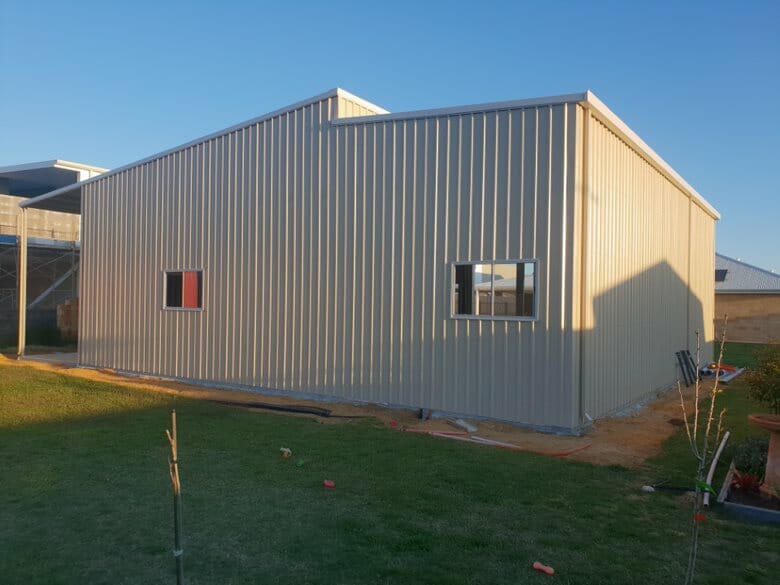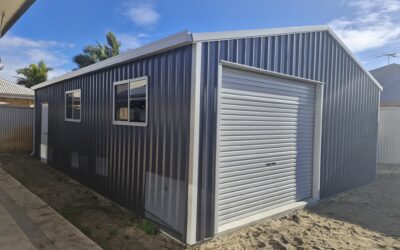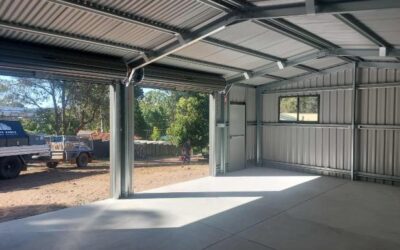The Spinifex Sheds Guide to Shed Ventilation
Who doesn’t love rushing out of the shed with their t-shirt pulled up to cover nose and mouth, coughing and spluttering and choking on paint fumes? How about the fear of carbon monoxide poisoning sitting in the back of your head when you fire up that engine swap for the first time, and the freshly-built Barra pumps exhaust gases far too rich into your way-too-small space?
Maybe your shed’s just damp, and you can’t seem to dry it out for love or money, or it’s so hot you don’t even need a cabinet to cure beef jerky & biltong.
We’re not going to waste your time telling you why ‘shed ventilation is important’ or why ‘you need shed ventilation’. You know that, you’re probably here because you want a shed with great ventilation, but your current shed just isn’t cutting the mustard.
Also Read – 5 KEYS TO CHOOSING THE RIGHT-SIZED SHED

“Use in a well-ventilated area…”
You might want a workspace that ticks the box when the spray can reads “only use in a well-ventilated area”. Somewhere you can glass a surfboard without feeling lightheaded, where you can lay down paint without racing against the clock (i.e, how long you can hold your breath). A shed that’s full of fresh air, moving the nasty fumes on their merry way.
Maybe, you’re just sick of a shed that’s stinking hot in summer and too cold to open the windows in winter; leading to mould, mildew and smells. Did you know that the shed insulation on the market is fantastic stuff, and can seriously change the way you enjoy your shed?
We’ve also written an article on managing moisture in your shed, if that’s what you need be sure to check it out.
Luckily for you, here at Spinifex Sheds we know a thing or two about proper shed ventilation. How to retrofit it, what the legal requirements are and, if it comes to it, how to build a brand new shed that’s not only well ventilated, but will have you wondering why you never pulled the trigger sooner.
Here’s everything you need to know about achieving fantastic shed ventilation, and all your options.
Naturally Aspirated vs Forced Induction
Before we start listing different methods of ventilation, let’s touch briefly on filtration & forced ventilation systems vs regular passive ventilation; i.e. a whirly bird on the roof. If you’re working with particular toxic fumes, it’s probably a good idea to look into filtration, extraction and forced circulation rather than slapping a few windows in and calling it a day. By the same token, if you’re an avid woodworker, a proper dust extraction system is probably what you’re after.
Similarly, if you’re looking for shed ventilation for your residential shed, and don’t plan to be doing anything commercial or business related from the premises, you’re not subject to strict environmental pollution requirements (*we’re not lawyers, so don’t take this for legal advice. If you’re unsure, contact your local government body or council. We accept no responsibility if you get done by the EPA).
To the best of our knowledge, if you’re spraying your car, fixing a few surfboards and emitting a small amount of VOCs into the atmosphere, you should be ok. While it’s not the best thing for the planet, you shouldn’t have the EPA knocking on your door (again, not lawyers & this isn’t legal advice).
If you are planning to charge people for your services or sell your finished surfboards or painted products, you’ll need to double check all the relevant regulations and make sure you comply.
Shed Ventilation Systems: Passive & Active
You’re probably well aware of the classic roof-top whirlybird. They’re the quintessential roof vent, and that’s what we’d call an ‘active’ (but unpowered) ventilation system. The wind spins the whirlybird, and that sucks air up and out of the shed.
The flip side is what we’d call a ‘passive’ system. This form of shed ventilation basically relies on the principle of hot air rising—the air moves out of the shed through vents under the gables or in the eaves, and is replaced by fresh, cooler air that enters the shed through vents low on the walls.
Passive ventilation systems have their merits as they’re silent and don’t require maintenance, and can’t really break. Although, a good whirlybird is generally silent too, robust, and far more effective. It’s best to choose a ventilation system based on what you expect your requirements to be.
If you only need ventilation to ease temperatures a little, keep a handle on potential moisture issues in winter, and to make sure smells are able to escape—you’ll probably be fine with something like a louvred wall vent. If you’re planning to paint, work with chemicals or automotive fluids and really want to keep the fumes down, go with a quality whirlybird.
So, what are the options?
1. The Classic; Louvred Vents
Vents up high and vents down low. The air inside the shed gets warm, rises out the top vents and is replaced by cool air sucked through the lower vents. Cheap, effective and simple with nothing to go wrong. A little mesh on the inside prevents bugs, critters and mice, and the louvres keep water out when it rains.
Pros; Simple, cheap, silent, low-key aesthetically.
Cons; They aren’t going to keep you fume-free when getting serious.
2. The Ridgeline Vent
Available from a variety of different manufacturers, ridge line vents are still passive ventilation, but essentially far more effective. They’re a slightly raised ridge cap of your shed, allowing hot air to rise and exit from the highest point of your roof, without letting rain in. You can run them for a short distance, or for the entire length of your shed for maximum ventilation.
They use the same principle as louvred vents, but are much more effective. Still, don’t expect to tune your car’s AFRs inside with the door closed, relying only on this ventilation system.
Pros; Simple, no-maintenance, decent ventilation performance
Cons; Less affordable than louvred vents, and more difficult to retrofit. Still best for maintaining air quality, rather than serious ventilation.
3. The Old Faithful; Windows & Doors
If your shed doesn’t get particularly damp or musty, and you’re not planning to store things that need constant ventilation or regularly paint up a storm while it’s raining, consider just adding doors and windows.
Retrofitting windows into a Colourbond shed can transform your space. The amount of light a single extra window can give you is nothing to scoff at. More light generally means easier to work, at least in the day, and more enjoyable. If you’re painting, test running a mower or whipper snipper, throwing the windows open will give you plenty of ventilation.
If you’re worried about security, adding some corrugated security screening won’t detract much at all from the amount of light you’ll get, or the ventilation, and the window will be as secure as the regular sheet metal walls.
Pros; Light, LOTS of ventilation when open, relatively straightforward to install.
Cons; One of the more expensive options on the list so far. Obviously, they only work when they’re open, which might be a problem if it’s raining heavily.
4. Whirlybirds.
The most effective insulation without adding electricity, whirlybirds spin quickly in even a gentle breeze, and even on the hottest day they still serve as a vent to let the hot air rise out the top of your shed. For the serious DIY’er, or even the home shed-based professional, whirlybirds are your best bet.
For the greatest results, pair them with windows or one of the other passive ventilation options.
Traditionally, roof-mounted whirlybirds get a little bit of negative press for being ‘noisy’ or ‘prone to breaking’ or ‘unsightly’, but with our genuine Ranbuild options these issues just aren’t issues any more.
With self-lubricating steel bearings, they’re virtually maintenance free and silent. A strong, robust design means they’re not only going to last a lifetime, but they’ll hold up in harsh weather conditions and strong wind as well as the rest of the shed. Because they’re a genuine Ranbuild product, they’re available in the complete range of Colourbond Steel colours, so they blend in seamlessly with your shed roof and look great.
They’ve got great extraction rates, and are completely leak proof—no nasty wet spot to keep clear when it rains. If it wasn’t obvious, we really recommend whirlybirds for your shed ventilation system, particularly these ones.
If you need a little more convincing, feel free to give us a ring and we’ll rave about them some more.
Pros; Best in class extraction.
Cons; Install needs a little more finesse.
Is it time for a new shed?
If you’ve been reading this article and shaking your head at the options, sure none of them are going to work with an older shed that’s not quite up to the task, or a little too small, or a little too cramped—maybe it’s time for a new one. Here at Spinifex Sheds, we’re one of Australia’s top shed builders because we do a damn good job. We offer the complete Ranbuild range of sheds, and specialise in custom designs to give you exactly the shed you need.
We’ve built more than a shed or two over the years, and have become particularly good at helping people work out exactly what they need and designing the perfect solution. Council approval got you worried? We’ll take care of that too.
If you’ve been looking for a sign to pull the trigger on an awesome new shed, here it is.
Similar Articles
Man Shed Ideas: Turn Your Shed Into a Personal Escape
A shed’s never just a box with a door. It’s where you stash the gear, sort your tools, or line up your next project. Whether you’re fixing the ute, catching the footy, or just want a spot to disappear for a bit, the right setup makes all the difference. Even if it’s just for storage, it should still be tough, weatherproof, and built to last.
How to Keep a Shed Cool in Summer
If you’ve spent a summer working out of a steel shed in the WA heat, you know how fast it can turn into a sweatbox. Whether you’re parking gear, storing feed or knocking out a few jobs in the shade, the last thing you want is to step into an oven every time you open the roller door
How to Build a Machinery Farm Shed (Properly)
Machinery is the backbone of any farm. Tractors, headers, sprayers, seeders. These are big investments that keep everything moving. Leaving them out in the weather or under a flimsy shed leads to rust, costly repairs, and downtime when you least need it.






